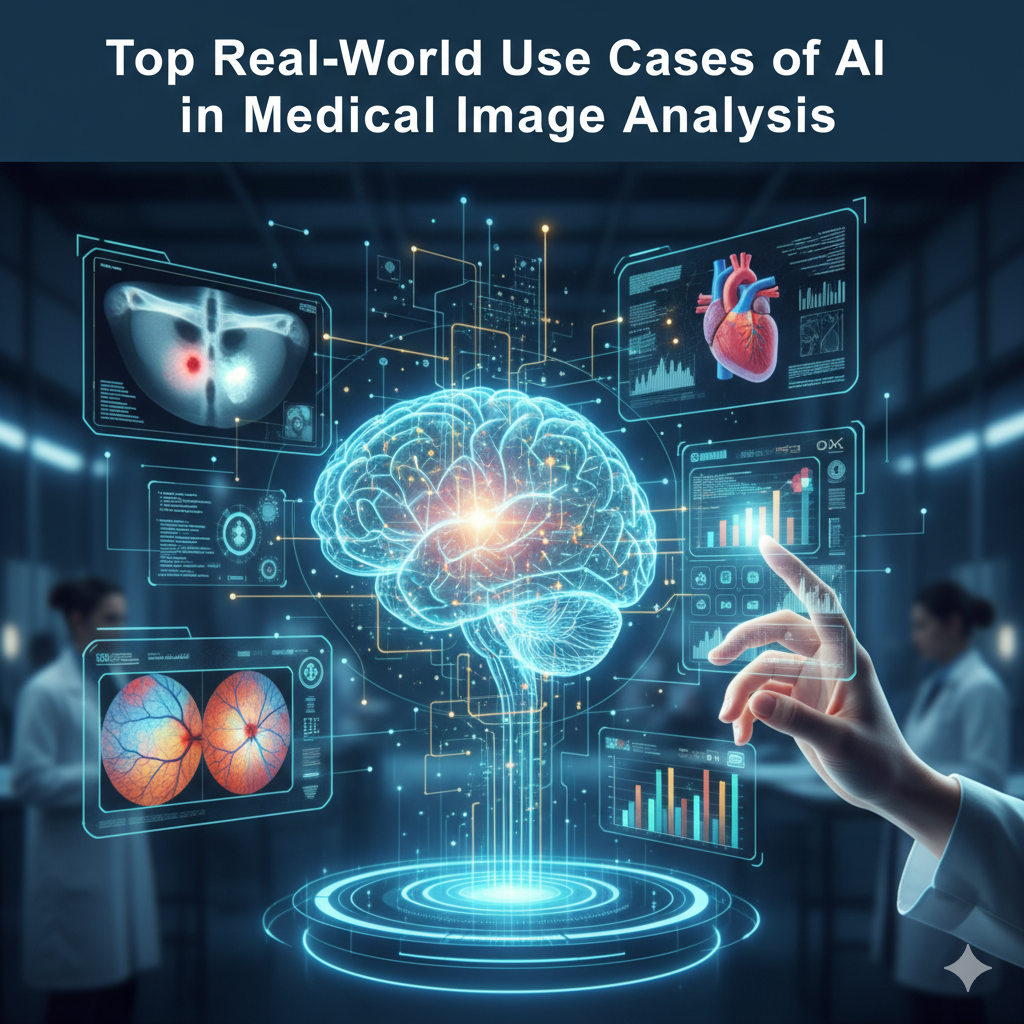AI in medical image analysis is transforming the face of diagnostics, advancing accuracy, efficiency, and early disease recognition across a wide range of specialties.
Hospitals and health providers are overwhelmed with increasing imaging volumes and demand for faster interpretation, driving the need for AI solutions to make clinical decisions more quickly and accurately.
In this blog, we examine why medical imaging requires AI and identify the best real-world use cases that are revolutionising patient care.
Why Medical Imaging Needs AI?
The modern healthcare system is facing a data deluge. A single CT or MRI scan can consist of thousands of individual images, and hospitals generate petabytes of imaging data annually.
This massive volume has placed an immense burden on radiologists and pathologists, who are tasked with meticulously examining each image for often subtle signs of disease.
This environment creates a perfect storm of challenges: specialist shortages, radiologist burnout, and the inherent risk of human error in high-volume, repetitive tasks.
This is precisely where AI enters the picture. AI, particularly deep learning, thrives on large datasets. It can analyze thousands of images in the time it takes a human to review a single case, detecting complex patterns that may be invisible to the human eye.
It doesn't get tired, offering a consistent and objective "second opinion." AI's role isn't to replace expert clinicians but to empower them.
7 Use Cases of AI in Medical Image Analysis
1. Early Disease Detection
One of the key benefits of AI in Medical Image Analysis is early disease diagnosis. AI algorithms are able to recognize abnormalities such as tiny tumors, microcalcifications, lung nodules, or irregular patterns of tissue long before they appear in traditional exams.
As an instance, AI algorithms used in breast cancer screening are more sensitive in the identification of malignancy and result in the complete eradication of false negatives.
In the same way, AI-based lung CT models can also detect early-stage lung cancer nodules that would allow for faster planning of treatment. This preventative approach helps increase survival rates with healthier long-term results.
2. Automated Image Segmentation
Image segmentation is essential in diagnostics, treatment planning, and surgical preparation. Manual segmentation is time-consuming and subject to inter-observer variability. AI automatically segments organs, lesions, tissues, and anatomical structures with exceptional accuracy.
Examples include:
- Brain tumor boundary segmentation in MRI.
- Liver, kidney, and prostate segmentation for surgical planning.
- Tumor volume estimation for oncology workflows.
By lessening the workload of humans at the console, AI allows radiologists to concentrate on thinking instead of clicking.
3. Radiology Workflow Automation
The impact of AI isn't just clinical; it's operational. AI is revolutionizing the entire radiology workflow, saving time and resources. One of the most significant applications is automated triage.
AI systems can pre-scan an entire queue of patient images (e.g., head CTs from the emergency department) and flag time-sensitive, critical cases, like a potential stroke or brain bleed, moving them to the top of the radiologist's worklist.
This simple prioritization can cut interpretation times for urgent cases from hours to minutes. Other workflow tools automate scan protocoling, patient scheduling by predicting no-shows, and even auto-generation of standardized reports.
4. Image Quality Enhancement
Medical images are sometimes compromised by noise, low resolution, or artifacts that obscure diagnostic details. AI-based enhancement techniques improve image quality without requiring patients to undergo additional scans or radiation exposure.
Models based on deep learning algorithms, which are trained with high-quality images from reference datasets, can denoise scans, upscale resolution, or reconstruct missing data when scanning is incomplete.
In CT, AI can be used to achieve a low-dose protocol, resulting in a lower dose of radiation and diagnostic quality. In MRI, AI speeds up scan times by reconstructing high-quality images from fewer measurements, increasing patient comfort and throughput.
5. Predictive Diagnostics
AI enables the prediction of disease progression, recurrence, and risks with the help of past imaging data and patient health records. Prospective diagnostics are especially relevant in chronic conditions, including cancer, neurological diseases, and cardiovascular disorders.
Examples include:
- Predicting tumor growth over time
- Prediction of response to treatment in oncology
- Risk of future strokes or other heart attacks
- Screening the diabetic patients at risk of insulin-related problems
This empowers clinicians to personalize treatment, intervene early, and achieve better patient outcomes.
6. Ophthalmology Imaging
AI in ophthalmology helps identify retinal conditions through automated analysis of fundus images and OCT scans. Deep learning models can detect diabetic retinopathy, glaucoma, macular degeneration, and retinal detachments with high accuracy.
Many AI-powered screening tools are already approved for real-world clinical use. These solutions enable early detection in remote or underserved areas, significantly reducing preventable blindness.
Automated grading also supports ophthalmologists by reducing workload and standardizing results.
7. Cardiology Imaging
AI assists cardiologists in analyzing ECG, echocardiography, CT angiography, and cardiac MRI images. It helps detect blockages, heart wall abnormalities, ejection fraction issues, and early signs of heart failure.
AI-based echocardiogram interpretation tools can automatically measure chamber sizes, valve movements, and cardiac function in real time. In coronary CT, AI algorithms highlight stenosis, plaque build-up, and vessel abnormalities, supporting faster and more accurate decisions.
This leads to timely intervention, reduced diagnostic errors, and improved cardiovascular outcomes.
Conclusion
The AI in Medical Image Analysis is changing the whole scenario of the healthcare sector by facilitating faster diagnosis, better accuracy, and an efficient process across different specialties.
The use of AI in medical imaging will lead to considerable improvements in patient outcomes as more and more hospitals opt for AI-powered imaging solutions.
If your organization is planning to innovate or upgrade its diagnostic capabilities, this is the perfect opportunity to create AI-based medical image analysis software and be a step ahead in the intelligent healthcare future.





Comments